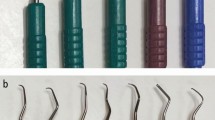Abstract
Data sources
Sources of studies were the Cochrane Oral Health Group List of Systematic Reviews in Dentistry, Database of Abstracts of Reviews of Effectiveness, Medline, Embase, and Scisearch. No date or language restriction was imposed. Reference lists of located reviews were checked for additional references.
Study selection
Twelve reviews addressing the question were included.
Data extraction and synthesis
A narrative appraisal of the reviews was conducted.
Results
A number of implications for clinical practice were identified. These are as follows:
Initial therapy:
-
In people who have periodontitis, mechanical nonsurgical pocket therapy reduces inflammation and pocket depth and increases clinical attachment level.
-
The magnitude of pocket depth reduction correlates with greater pocket depth before treatment.
-
Nonsurgical mechanical debridement may cause loss of attachment in shallow pockets (≤3 mm).
-
There is no evidence of any difference in efficacy between machine-driven (ultrasonic and sonic) and hand instruments in single-rooted teeth. Machine-driven instruments may be faster than hand instruments.
-
Adjunctive therapies have been developed and investigated but, to date, no therapy exists as a stand alone replacement for mechanical nonsurgical pocket therapy.
Maintenance therapy:
-
In periodontal maintenance patients, mechanical debridement reduces inflammation and disturbs the bacterial biofilm, which is thought critical to disease control including prevention of progression.
-
The effect of mechanical nonsurgical pocket therapy on pocket depth reduction and clinical attachment gain in maintenance patients is unclear; maintenance or stability of pocket probing depth and clinical attachment level, however, has been demonstrated and meets the goal of maintenance therapy.
-
There is not clear evidence to form recommendations over time taken, thoroughness and frequency of mechanical debridement for periodontal maintenance care.
Conclusions
Existing evidence in the form of systematic reviews — the highest level of evidence for evaluating a therapy — provides conclusive support for the beneficial effect and efficacy of mechanical nonsurgical pocket therapy in the treatment of periodontal diseases.
Similar content being viewed by others
Commentary
The basic goal of periodontal therapy is to help dental patients preserve a functional natural dentition. With significant advances in the fields of genetics, immunology and microbiology we understand better the aetiology and pathogenesis of periodontal disease. Despite these advances, however, we continue to use the same basic therapy: this was even described by Abu'l-Qasim in the first century AD.1 Disruption of the plaque biofilm and removal of bacterially retentive factors remain the key to preventing, and stopping progression of, periodontal infections. Initial therapy, nonsurgical therapy, sanative phase, scaling and root planing, and mechanical debridement are simply different names for this process.
Suvan has presented a thorough review of the published reviews on the subject of nonsurgical periodontal therapy, presenting recommendations for clinical practice and future research based on the available evidence. One of the more interesting things in this paper is not the result of her review; she has, appropriately, probed deeper, examining the value of some statistical methods and questioning the type of outcomes used in clinical trials. As an example, one of the problems with interpreting evidence from periodontal trials prior to the early 1990s is the assumption of independence of data. Each periodontal probing site was seen as independent of all other sites on the same tooth, and in the same mouth, and thus pooled for analysis. Yet, as early as Hirschfeld and Wasserman's study nearly 30 years ago2 we have known that the majority of disease is present in the minority of sites, and in a minority of patients. As a result, pooling of the data from every single site measured in a study overestimates the treatment's true effect. Additionally, some of the earlier studies focused on outcomes using single rooted teeth, thus ignoring the areas where disease is most likely to occur!
Clinical studies have always measured outcomes that are most important to clinicians, and in as quantifiable way as possible. Most patients, however, do not care if the disto-lingual of the lower right second molar decreases by 1.3 mm. They want to know if the treatment will help them keep their teeth longer, prevent them from needing surgery and how much it will cost.
In extrapolating research results we must keep in mind the difference between a treatment that is efficacious, that is, beneficial under controlled circumstances (as in most clinical trials), effectiveness, that is, beneficial under most day-to-day circumstances, and efficiency, in which case the benefits outweigh the risks. Risks can include side effects, as well as the use of time (both the patient's and the clinician's) and costs. Thus, efficiency is the most useful information to help patients and their clinicians make the most appropriate clinical decisions. Unfortunately, few clinical trials address the issues of patient-based outcomes or opportunity costs.
Despite the lack of evidence supporting the effect or efficacy of mechanical nonsurgical periodontal therapy, clinical experience tells us that this is the best single therapy option available. Until such time as there is sound evidence of efficiency, we must continue to use the information we have from clinical research, together with our best clinical judgment (with all its inherent biases) as to when, where, and in whom mechanical therapy is required.
References
Albucasis . La Chirurgie. Translated by L. LeClere. Paris: Bailliére, 1861.
Hirschfeld L, Wasserman B . A long-term survey of tooth loss in 600 treated periodontal patients. J Periodontol 1978; 49:225–237.
Author information
Authors and Affiliations
Additional information
Address for correspondence: J Suvan, Department of Periodontology, Eastman Dental Institute for Oral Health Care Sciences, University College London, Gray's Inn Road, London WC1X 8LD, UK.
Suvan JE. Effectiveness of mechanical nonsurgical pocket therapy. Periodontol 2000 2005; 37:48–71
Rights and permissions
About this article
Cite this article
Matthews, D. Conclusive support for mechanical nonsurgical pocket therapy in the treatment of periodontal disease. Evid Based Dent 6, 68–69 (2005). https://doi.org/10.1038/sj.ebd.6400338
Published:
Issue Date:
DOI: https://doi.org/10.1038/sj.ebd.6400338



